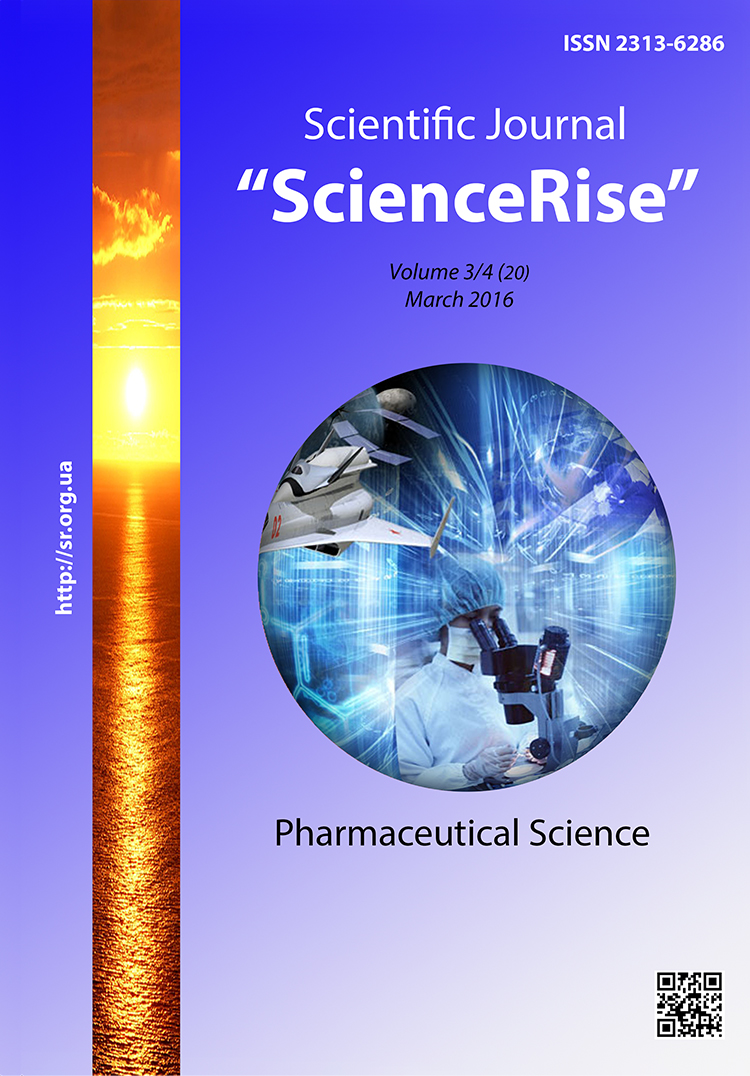Development of methods for standardization of tablets with aspen bark extract
DOI:
https://doi.org/10.15587/2313-8416.2016.65119Keywords:
tablets, peptic ulcer disease, aspen bark dry extract, flavonoids, phenol carbonic acids, standardizationAbstract
Aim. Development of methods for standardization (identification and assay) of tablets with aspen bark extract.
Methods. Tablets containing dry extract of aspen bark, 0.05 g, were the object of research. For dry aspen bark extract identification a thin layer chromatography (TLC) method was used. Silica Gel 60 F254 («Merck», Germany) TLC plates, «CAMAG» TLC developing chamber, Linomat 5 («CAMAG», Switzerland) applicator, «CAMAG» UV-lamp to scan the chromatogram, and standard samples of hydroxycinnamic acids and flavonoids were used. Exact mass of standard samples were dissolved in appropriate volumes of methanol. To quantify hydroxycinnamic acids, spectroscopy method was used by Cary-50 Spectrometer. The hydroxycinnamic acids content calculated as caffeic was determined.
Results. On the basis of modern approaches to standardization of herbal medicines methods for qualitative and quantitative determination of active pharmaceutical ingredients of aspen bark extract in tablets were developed. The presence of phenolcarbonic acids and flavonoids (TLC method) were considered as identification criteria of aspen bark extract quality in developed tablets. Taking into account phenolcarbonic acids content in aspen bark extract and the extract content in developed tablets, as well as results of developed tablets analysis, it was theoretically proved and experimentally confirmed that phenolcarbonic acids content in the range from 2.7 to 3.3 mg calculated as the average tablet weight and caffeic acid should be chosen as quantitative criteria of developed tablets.
Conclusion. Methods for identification and quantitative determination of aspen bark extract in tablets were developed; study in area of the selection of tablets quality indicators was carried out
References
Anishchenko, O. V. (Ed.) (2011). Medyko-demohrafichna sytuaciia ta orhanizaciia medychnoi dopomohy naselenniu u 2010 rotsi: pidsumky diialnosti systemy okhorony zdorovia ta realizatsia Prohramy ekonomichnykh reform na 2010–2014 roky «Zamozhne suspilstvo, konkurentnospromozhna ekonomika, efektyvna derzhava» [Medical and demographic situation and organization of medical care for population in 2010: results of the health system activity and the implementation of the program of economic reforms in 2010–2014 «Prosperous Society, Competitive Economics, Effective State»]. Kyiv: MPH of Ukraine, 104.
Fadeenko, G. D., Kolesnikova, E. V. (2015). Mesto vismuta subcitrata v kompleksnoj terapii pacientov s jazvennoj bolezn'ju, associirovannoj s Nelicobacter pylori. Suchasna gastroenterolіja, 1 (81), 37–43.
Onyshkiv, O. I., Vasenda, M. B. (2012). Marketyngove doslidzhennja vitchyznjanogo rynku gastroenterologichnyh likars'kyh zasobiv. Farmacevtychnyj chasopys, 1, 79–82.
A02 Preparaty dlja lechenija kislotozavisimyh zabolevanij. Kompendium. Available at: http://compendium.com.ua/atc/A02
Onyshkiv, O. I. (2015). Optymizacija skladu ta tehnologii' tabletok ekstraktu kory osyky. Aktual'ni pytannja farmacevtychnoi' i medychnoi' nauky ta praktyky, 1 (17), 40–43.
Onyshkiv, O. I., Groshovyj, T. A., Koval'ov, S. V., Borodina, N. V., Derkach, N. V., Maloshtan, L. M. (2012). Pat. № 70554 Ukrai'na, MPK A61K 36/00, A61K 31/00. Tabletovanyj protyvyrazkovyj likars'kyj zasib. u201202204; zajavl. 24.02.12; opubl. 11.06.12, Bjul. № 11.
Borodina, N. V. (2007). Farmakognostychne vyvchennja roslyn rodu Populus L. Kyiv, 20.
Borodina, N. V., Koval'ov, V. M., Dykyj, I. L., Derkach, N. V., Maloshtan, L. M., Volkovoj, V. A. (2004). Pat. 2003054434 Ukrai'na A61K 36/89, A61K 36/89, A61P 13/12, A61P 23/00, A61P 25/04, A61P 29/00, A61P 31/04. Sposib vydilennja biologichno aktyvnyh rechovyn z kory osyky, jaki vyjavljajut' antymikrobnu, reparatyvnu, protyzapal'nu, anal'getychnu ta diuretychnu aktyvnist'. zajavl. 19.05.2003; opubl. 15.12.2004, Bjul. № 12.
Tureckova, V. F., Lobanova, I. Ju., Rassypnova, S. S. et. al (2011). Osina obyknovennaja kak perspektivnyj istochnik poluchenija preparatov protivojazvennogo i protivovospalitel'nogo dejstvija. Bjuleten' sibirskoj mediciny, 5, 106–111.
Talykova, N. M., Ekshibarova, O. A. (2004). Poluchenie, analiz i ustanvolenie antioksidantnoj aktivnosti otara, nastoek i jekstrakta zhidkogo iz kory osiny obyknovennoj. Sovremennye naukoemkie tehnologii, 6, 31–32.
Borodina, N. V., Koval'ov, V. M. (2004). Kil'kisne vyznachennja fenol'nyh spoluk Populus tremula L. Farmakom, 1, 1–4.
Derzhavna Farmakopeja Ukrai'ny. Dopovnennja 1 (2004). Kharkiv: RIREG, 492.
Derzhavna Farmakopeja Ukrai'ny. Dopovnennja 2 (2008). Kharkiv: DP NEFC, 620.
Derzhavna Farmakopeja Ukrai'ny. Vol. 3 (2014). Kharkiv: DP NEFC, 732.
Yezerska, O., Kalynyuk, T., Vronska, L. (2013). Quantitative determination of hydroxycinnamic acids in chicory root. Сhemistry and Chemical Technology, 7 (3), 247–250.
Downloads
Published
Issue
Section
License
Copyright (c) 2016 Оксана Іванівна Онишків, Людмила Вікторівна Вронська, Тарас Андрійович Грошовий

This work is licensed under a Creative Commons Attribution 4.0 International License.
Our journal abides by the Creative Commons CC BY copyright rights and permissions for open access journals.
Authors, who are published in this journal, agree to the following conditions:
1. The authors reserve the right to authorship of the work and pass the first publication right of this work to the journal under the terms of a Creative Commons CC BY, which allows others to freely distribute the published research with the obligatory reference to the authors of the original work and the first publication of the work in this journal.
2. The authors have the right to conclude separate supplement agreements that relate to non-exclusive work distribution in the form in which it has been published by the journal (for example, to upload the work to the online storage of the journal or publish it as part of a monograph), provided that the reference to the first publication of the work in this journal is included.

